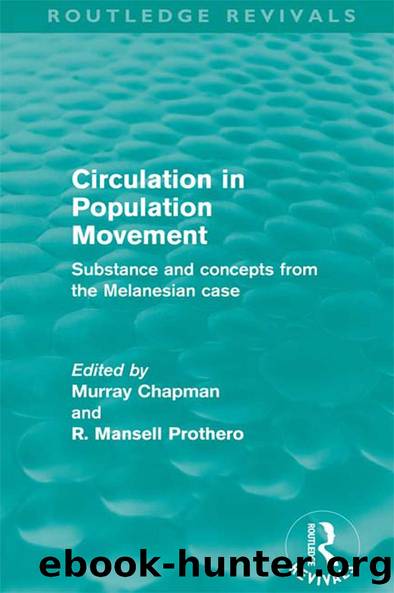Circulation in Population Movement (Routledge Revivals) by Murray Chapman R. Mansell Prothero

Author:Murray Chapman, R. Mansell Prothero [Murray Chapman, R. Mansell Prothero]
Language: eng
Format: epub
ISBN: 9780415528290
Barnesnoble:
Publisher: Taylor & Francis
Published: 2013-04-01T00:00:00+00:00
Conclusion
The To'ambaita are now firmly established in Honiara, having exhibited considerable success at seizing opportunities as they became available. This process has been slow and occurred against the background of continuing circulation between Malaita and town. As paid employment grew more attractive and upward mobility became possible, small but increasing numbers became regular and stable workers, often remaining after marriage and especially since 1968, when the family-housing scheme was initiated. Early in the 1960s a form of segmentation became apparent, based largely on differences in formal education and distinguished by a comparative divergence in job mobility and socioeconomic success.
Moving to places of employment arose out of the separation of them from the To'ambaita territory on Malaita. Wage work has always been attractive because it offered more income than was available locally â a differential that still persists despite the growth of cash cropping and other money-earning activities on the home island. When To'ambaita undertook short-term labour circulation, these inequalities of earning capacity were temporary; with more continuous involvement in paid employment they became more sustained; with upward social mobility they are also much greater and definitive. Even so, short-term circulation for low-income and unskilled jobs will continue amongst two kinds of To'ambaita: the young, for whom there is the added attraction of urban life styles; and villagers from the poorer settlements who have few opportunities to earn money. If present trends continue, stratification will likely increase amongst To'ambaita and all Solomon Islander migrants living in Honiara, as differences in socioeconomic status become more sharply defined. Much prestige and respect already attaches to the most successful government employees, skilled workers, and businessmen.
Families and kin share in the successes of To'ambaita migrants, who continue to affirm rural-based ties and to demonstrate attachment to their natal communities. Even with the advantages the To'ambaita now enjoy in town, they are not totally committed to working there and do not regard Honiara as their permanent place of residence. Research in Papua New Guinea, amongst peoples with more extended experience of urban residence (Morauta 1981; Morauta and Ryan 1982), suggests that as these social ties change through the death of parents and siblings and as children born and raised in town become more used to urban rather than rural environments, then the context of decision making changes and it becomes more inevitable to stay in town. At this stage of To'ambaita experience, the option of returning to north Malaita remains important even if not exercised with the same certainty as in earlier decades of wage-labour circulation. Even as this option is expressed, many are making themselves more secure in Honiara (cf. Strathern, this volume). In the mid 1970s, the balance between going back âhomeâ and staying âin townâ (âlong taonâ) for an extended period turned on success in both employment and business. As more To'ambaita experience such success the process of segmentation, described here at a very formative stage, will not only continue but also become more pronounced.
Download
This site does not store any files on its server. We only index and link to content provided by other sites. Please contact the content providers to delete copyright contents if any and email us, we'll remove relevant links or contents immediately.
Man-made Catastrophes and Risk Information Concealment by Dmitry Chernov & Didier Sornette(5651)
The Revenge of Geography: What the Map Tells Us About Coming Conflicts and the Battle Against Fate by Kaplan Robert D(3962)
Zero Waste Home by Bea Johnson(3655)
In a Sunburned Country by Bill Bryson(3369)
COSMOS by Carl Sagan(3350)
Good by S. Walden(3347)
The Fate of Rome: Climate, Disease, and the End of an Empire (The Princeton History of the Ancient World) by Kyle Harper(2874)
Camino Island by John Grisham(2720)
A Wilder Time by William E. Glassley(2690)
Organic Mushroom Farming and Mycoremediation by Tradd Cotter(2567)
The Ogre by Doug Scott(2501)
Human Dynamics Research in Smart and Connected Communities by Shih-Lung Shaw & Daniel Sui(2431)
Energy Myths and Realities by Vaclav Smil(2381)
The Traveler's Gift by Andy Andrews(2300)
9781803241661-PYTHON FOR ARCGIS PRO by Unknown(2269)
Inside the Middle East by Avi Melamed(2231)
Birds of New Guinea by Pratt Thane K.; Beehler Bruce M.; Anderton John C(2175)
A History of Warfare by John Keegan(2106)
Ultimate Navigation Manual by Lyle Brotherton(2050)
